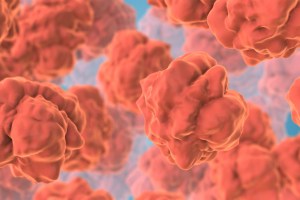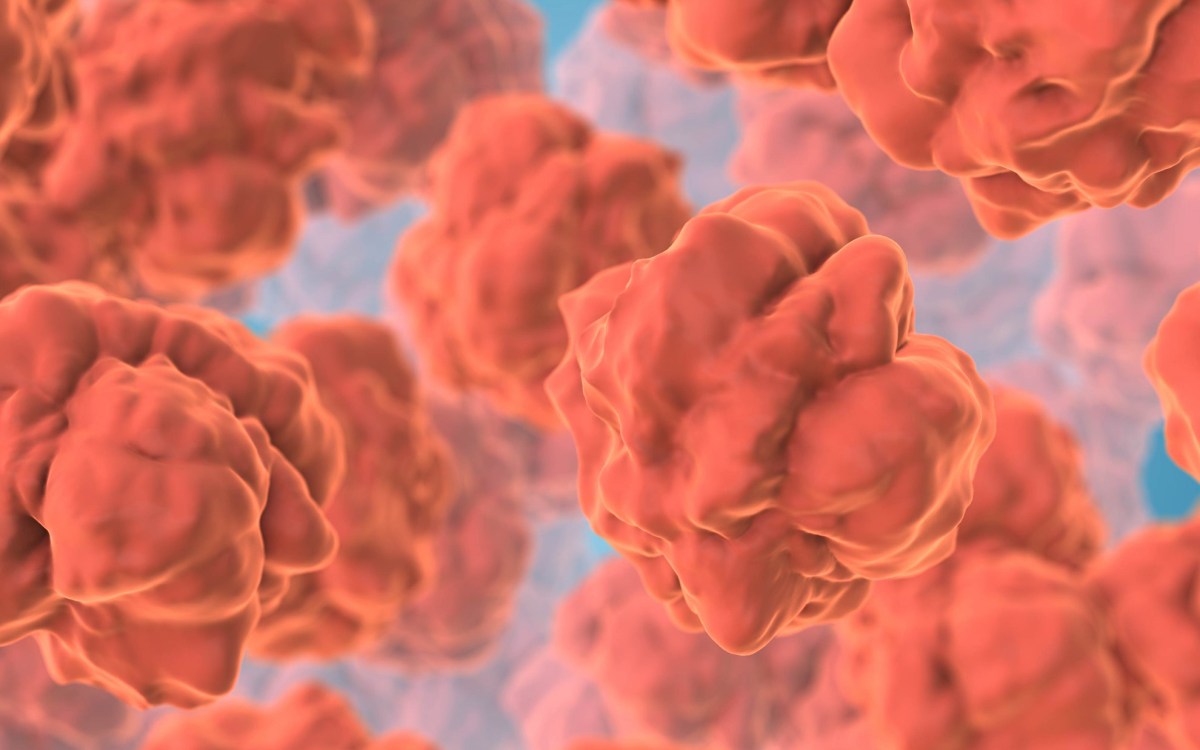M. Judah Folkman, biomedical pioneer, dies at 74
Surgeon, research scientist, teacher and mentor, created field of angiogenesis
One of Harvard Medical School’s (HMS) most forward-looking and innovative physician-scientists, M. Judah Folkman, died suddenly Monday (Jan. 14) after suffering a heart attack at the Denver International Airport in Denver. He was 74.
Folkman is widely known as a pioneer in the study of angiogenesis, the growth of new blood vessels. His findings in his laboratory at Children’s Hospital Boston, and the hundreds of people he helped train, are blossoming now to produce useful anti-cancer treatments, new approaches to eye disorders, and benign plastics that leak therapeutic drugs at precise rates. The latter made possible the development of the contraceptive Norplant.
Although often dismissed by colleagues and opponents as stubborn, or simply wrong, Folkman has a lifetime record of solid, innovative, and productive achievement. Drugs based on his ideas — that tumors need blood, can recruit a blood supply of their own, and can be blocked — are now in use worldwide. They are extending lives, and restoring sight for the blind.
A devastating loss
Announcing Folkman’s death to the Children’s Hospital community of which Folkman was a part for more than 50 years, Children’s President and CEO James Mandell wrote, “It is with tremendous sadness that I must announce the passing of one of the most cherished members of Children’s community, Dr. Judah Folkman. This is a devastating loss to not only our hospital family, but the world at large.”
Mandell said Folkman was “a true visionary and scientific pioneer. When he first proposed in the 1970s that cancer could be kept in check by cutting off its blood supply, he faced skepticism from a scientific community that simply wasn’t ready for his ideas. But he persevered, even when there were setbacks. Today there are more than 1,000 laboratories worldwide engaged in the study of angiogenesis, the field he founded.”
And today, Mandell said, “more than 10 new cancer drugs are on the market, and more than 1.2 million patients worldwide are receiving anti-angiogeneic therapy.”
“Judah’s research combined fundamental understanding of tumorigenesis and angiogenesis with major practical applications of these insights,” said Jeffrey Flier, dean of Harvard Medical School. “In addition, he had a profound influence on generations of Harvard medical students. While directing an unusually large laboratory with many lines of inquiry,” Flier continued, Folkman “always made time for students and teaching. He was an extraordinary role model for faculty and students at Harvard Medical School.”
Harvard University Provost Steven E. Hyman called Folkman “a uniquely significant figure both within the Harvard community and beyond. Judah was a leader in moving basic science to the clinic, a major figure in cancer research, and a widely influential mentor.”
The rabbi’s son, the rabbi-like doctor
Folkman actually began his medical career in high school in Bexley, Ohio, volunteering in a hospital laboratory at Ohio State University. Born in 1933 in Cleveland, Ohio, Folkman accompanied his father, a rabbi, on visits to hospital patients. By age seven, he knew he wanted to be a doctor, rather than follow in his father’s footsteps, so he could offer cures in addition to comfort. His father replied, “In that case, you can be a rabbi-like doctor,” words his son took to heart.
This early calling led Folkman to Ohio State University, where, by the end of his freshman year, he was performing surgery on dogs under the mentorship of Dr. Robert Zollinger, then president of the American College of Surgeons. The young Folkman even designed a device to cool the liver during surgery without causing organ damage, and became coauthor on his first academic paper. With this experience, he was accepted into Harvard Medical School at the age of 19. By the time he arrived in Boston in 1953, he was already adept at surgery. He began research work while a medical student in the laboratory of Robert Gross, then chief of surgery at Children’s Hospital. In that setting, Folkman and a colleague at the Massachusetts Institute of Technology (MIT) invented the first implantable heart pacemaker. He graduated magna cum laude from HMS in 1957.
In the midst of his residency at Massachusetts General Hospital (Mass General), Folkman was suddenly drafted into the Navy, assigned to do research on artificial blood at a facility in Bethesda, Md. The assigned work was finished far earlier than expected, so Folkman and a colleague, pathologist Fred Becker, had free time in the laboratory and decided to study tumor cells growing in a special apparatus.
Why were tumors dying?
But their black melanoma cells only grew briefly, and Folkman saw something unusual: All the little tumors were exactly the same size. He reasoned that this wasn’t natural, so something must have halted their growth at a maximum size. What was it, he wondered.
That initial observation led to years of experimenting, thinking, arguing, and exploring until Folkman decided that the tumors had all stopped growing because they couldn’t get enough blood.
As this research continued, Folkman returned to his internship at Mass General, then began work at Boston City Hospital as a brilliant young surgeon. But in 1967, when he was only 34, Folkman was recruited to become chief of surgery at Children’s Hospital — but only if he’d leave for half a year for intensive training in pediatric surgery with C. Everett Koop in Philadelphia.
Although he served for years as chief of surgery at Children’s — always on call for the biggest emergencies — during that time Folkman kept pursuing his angiogenesis theories in his laboratory. At each step he ran into “impossibilities,” such as the conventional wisdom that blood vessel cells, endothelial cells, cannot be grown in culture. But he and Michael Gimbrone turned that common wisdom on its head, and the research finally got going.
A lonely voice – and a breakthrough
In the 1970s, when Folkman’s team applied for their first grant based on the hypothesis of angiogenesis and its role in tumor development and growth, reviewers at the National Cancer Institute summarily turned them down:
“It is common knowledge that the hypervascularity associated with tumors is due to dilation of host vessels and not new vessels and that this dilation is probably caused by the side effects of dying tumor cells. Therefore, tumor growth cannot be dependent upon blood vessel growth any more than infection is dependent upon pus.”
But in subsequent years, as a result of a huge number of experiments, failures, breakthroughs, and insights, Folkman and his colleagues were able to prove four major points: first, tumors do require blood to grow; second, tumors do recruit the blood vessel systems that bring in fresh blood; third, the recruiting mechanism involves hormone-like growth factors emitted by the tumor; and, fourth, the body makes natural factors that can shut down abnormal blood vessel growth, a phenomenon that Folkman named “anti-angiogenesis.” Two such factors, angiostatin and endostatin, were discovered in the Folkman laboratory by a young postdoctoral fellow, Michael O’Reilly.
Folkman always had a problem with too much public notice. His innovative ideas drew attention, especially from reporters covering science and medicine. As a result, news stories often trumpeted his successes, and desperate patients quickly besieged their doctors seeking a new “cure” that didn’t exist. Animosity within the profession — and doubts about Folkman’s wisdom — resulted. One prominent physician recalled, in fact, that “when I first heard of Judah Folkman, he was described as this guy in a hair shirt working on an island in Boston Harbor.”
The publicity problem became most extreme in May of 1998, when a New York Times reporter quoted Nobel-winning biologist James Watson as saying “Judah’s going to cure cancer in two years.” In the same article, Folkman was quoted as saying, “if you’re a mouse, we can take very good care of you.” But that didn’t end the controversy. Colleagues, facing anxious patients demanding cures that didn’t exist, were irate. And the Maryland company licensed to make and test angiostatin and endostatin, EntreMed Inc., saw its stock price skyrocket overnight.
Problems worsened when the two anti-angiogenic substances weren’t immediately successful in clinical trials. Hints of efficacy were seen in Phase I toxicity trials, but the number of patients was small and the results not impressive. The same was true for endostatin, although a handful of patients survived, without side effects, getting daily doses of endostatin for about four years, until Entremed stopped making it. Folkman was extremely upset by losing access to endostatin for his patients.
After that, news coverage was almost wholly negative, pointing to the two drugs — and anti-angiogenesis in general — as a colossal failure. Worse, the financial backing for clinical trials essentially dried up, and no major pharmaceutical firms stepped forward to resume clinical testing of endostatin and angiostatin. But recently, new industrial interest has emerged.
Vindication and real patient benefit
The picture changed dramatically about five years ago, when San Francisco’s Genentech Inc. reported success with a drug they named Avastin, which blocks the action of Veg-f, one of the stimulators of blood vessel growth. Clinical trials showed that infusing regular doses of Avastin actually extends the lives of patients with colorectal cancer. Since then, Avastin has been approved worldwide for use in such patients. It has also been approved for breast cancer patients in Europe, and is showing exciting promise against glioblastoma multiforme, a particularly dangerous form of brain cancer.
At least 50 angiogenesis inhibitors are now in clinical trials around the world, and more than 1,000 laboratories in universities and industry are conducting angiogenesis research. More than 10 angiogenesis inhibitors have been approved by the Food and Drug Administration, and anti-angiogenic drugs have received approvals in more than 30 other countries. More than 1.2 million patients worldwide are now receiving antiangiogenic therapy.
At the same time, research spawned in the Folkman laboratory by Anthony Adamis, collaborating with Joan Miller at Massachusetts Eye and Ear Infirmary, showed that the “wet” kind of macular degeneration, a blinding disorder caused by leaky blood vessels in the retina, can be halted, and even reversed, by anti-angiogenesis treatments. Many of the patients treated with such drugs are able to read smaller letters on the eye charts — and some resume reading, watching television, and even driving. It was a revolution in eye care.
When he arrived at Children’s Hospital for the second time in 1968, Folkman came aboard with a named professorship, the Julia Dyckman Andrus Professor of Pediatric Surgery. After stepping down as chief of surgery to concentrate on his angiogenesis research, Folkman began building a research team of extraordinary skill. One of his early postdoctoral fellows, chemical engineer Robert Langer, now an Institute Professor at MIT, has developed an early discovery that came from Folkman’s work.
While doing blood research for the Navy, Folkman had noticed that plastic tubing will gradually leak oil-based fluids, allowing the liquids to gradually get through the tubing walls. That led to a new drug-delivery system — implantable plastic capsules — that are in wide therapeutic use today. It led directly to the development of Norplant, the long-term contraceptive that is delivered via implantable plastic capsules. Langer holds about 400 patents based on such work, and has spawned numerous companies and a whole industry, and Folkman gave the original patent — leading to Norplant — to the Population Council.
Preparing the next generation
One of Folkman’s favorite occupations was training new doctors. He was a favorite lecturer at the Medical School, and he constantly emphasized responsibility and care for the patients. He once advised medical students that they were entering a service profession. And if they didn’t like long hours and being on-call, they could do something else. “You could be a banker instead,” he’d say.
Children’s Mandell noted that Folkman “has been a mentor to many, many researchers and physicians at Children’s. He was my mentor when I was a urologist-in-training, and I have gone to him for advice on more occasions than I can count. He has educated and inspired generations of young physicians and researchers, always drawing standing-room-only audiences at his presentations.”
That was far different from the early years, when he would rise to speak at cancer conferences only to see most of the audience get up and leave. In the past few years, as angiogenesis science has taken hold, doctors line up to hear his lectures.
Judah Folkman was a member of the National Academy of Sciences, the Institute of Medicine, the National Academy of Arts and Sciences, and the American Philosophical Society, among many other honorary appointments. He is an author on some 400 papers and more than 100 book chapters and monographs. He has received scores of United States awards and honors for his distinguished research, as well as numerous international awards, including Canada’s Gairdner Foundation International Award, Israel’s Wolf Foundation Prize in Medicine, Germany’s Ernst Schering Prize, the Italian Association of Cancer Research in Rome’s Gold Medal, the United Kingdom Society for Endocrinology’s Dale Medal, and Switzerland’s Dr. Josef Steiner Cancer Research Award. In 2006, Folkman was one of seven people appointed by President Bush to the National Cancer Advisory Board of the National Institutes of Health.
In 2006, a writer interviewing Judah Folkman for a profile in the Harvard Medical Alumni Bulletin asked him how he kept working. He responded:
“When Verdi was in his seventies, people asked him what his best opera was, and he answered, ‘I haven’t written it yet.’ When he was close to eighty, he wrote Falstaff. For me, the ideas keep coming, and maybe because of experience, they’re better and better. As long as these kinds of ideas are coming and we’re working on them, I should keep on going.”
Folkman is survived by his wife, the former Paula Prial, with whom he lived in Brookline, Mass., two daughters, and one granddaughter.
Robert Cooke is the author of “Dr. Folkman’s War: Angiogenisis and the Struggle to Defeat Cancer.”
Material from the Children’s Hospital Boston Department of Public Affairs was used in the preparation of this article.





